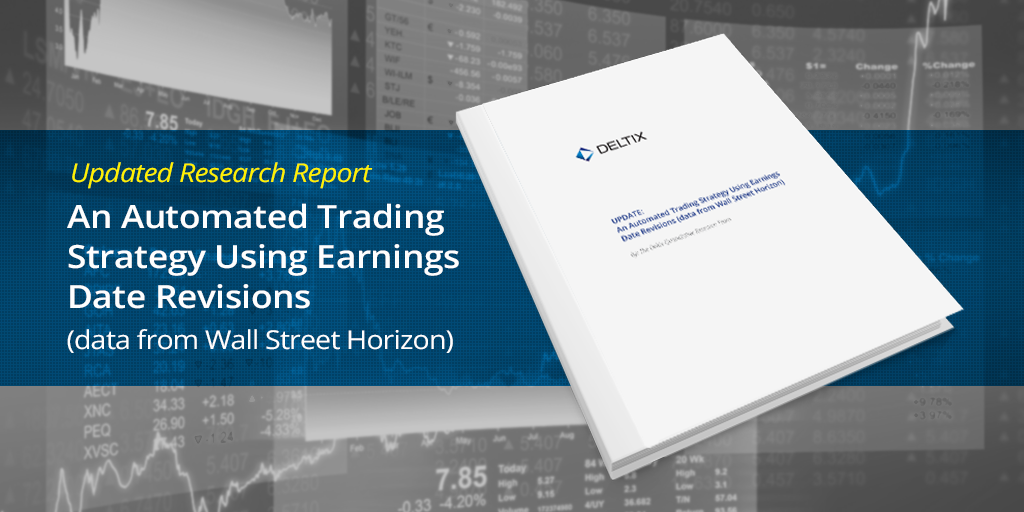
Research Update
This study is an update of the research using data from Wall Street Horizon that we first published on our blog in November 2015. At that time, we had data from January 2006 to September 2015. Now we have data to March 2017. We continue to be impressed by the stability of the returns.
We showed our approach for this study in our webinar on June 8th as an example of alpha research on our new DeltixQuantHub platform.
Introduction
Company earnings are the bedrock of financial analysis and investment. Sell-side, buy-side and independent research analysts perform quantitative and qualitative analysis of companies, their peers and their markets in order to provide guidance for short-term earnings and earnings growth for in-house use or for clients. Innovations in earnings analysis over the last few years have included crowd-sourced earnings estimates (e.g. Estimize) and sentiment derived from the news and social media (e.g. Ravenpack, Social Market Analytics). The overriding objective of company analysis has been and still is to forecast as accurately as possible a company’s future earnings and so guide asset allocation and trading decisions.
In this study, we looked at whether earnings announcement date revisions can be used for predicting future prices in a manner that could be profitably traded upon.
We reviewed the research papers of Joshua Livnat (http://www.wallstreethorizon.com/livnat) and Eric So (http://www.wallstreethorizon.com/So), both of whom look at whether changes in the earnings announcement dates can be used to generate returns.
Research Methodology
We conducted our study using our own research software, TimeBase and QuantOffice. In the webinar, we will show how this and other research can be back-tested in DeltixQuantHub, with full control over the parameters used in the study. Below are the steps we followed for this research:
- We populated TimeBase with WSH daily snapshots of company future earnings announcement dates for S&P500 stocks for the period January 3, 2006 to March 31, 2017.
- Corresponding with this time period, we also populated TimeBase with market data for those stocks. In production deployment of Deltix software, a time series of tick data is automatically recorded from real-time streaming market data. Whilst we used one-minute bar data for our research in this study, recording streaming tick data allows Deltix users to use any periodicity of data for their research.
- We now had a base data set, now with 11 years of data, on which to apply and test our ideas. Quant researchers use Deltix to express their model ideas as “strategies” in QuantOffice. Now with DeltixQuantHub, researchers will be able to publish their research to others and allow real interaction with the strategy in back-test.
- In the studies by Joshua Livnat and Eric So referenced above, both found that companies who advance their earnings dates generally outperform companies that delay their earnings dates. So we started with this premise and then developed the theme with advanced statistical techniques implemented in QuantOffice.
- The resulting model was back-tested, modified and back-tested iteratively. Again, in QuantHub, users will be able to run their own back-tests and test different parameter values.
- Where the earlier studies from Livnat and So modeled a holding period spanning from shortly after the change in date to the actual announcement, we took positions the day before an earnings announcement and sold them the day after, resulting on a holding period of less than 24 hours.
- In order to isolate the calendar date effect from any general market effect (although our holding period was less than a day), we also implemented a dollar-neutral version of the strategy. This was a simple extension to the trading strategy the effect of which can be isolated by a simple parameter.
Results
Our results supported the findings of the previous researchers. Specifically, we found:
- The most likely positive returns occurred when the earnings announcement date was advanced (i.e. brought forward) in the second half of the quarter.
- Conversely, the most probable negative returns occurred when earnings announcement date was delayed in the first half of the quarter.
For both hedged and un-hedged versions of the strategy, for the period January 2006 to March 2017, the back-tested strategies showed Sharpe Ratios of 1.96 (unhedged) and 1.99 (hedged) with average profit per share of 10 cents and 8 cents respectively. By comparison, in the prior study covering the period from January 2006 to September 2015, the back-tested strategies showed Sharpe Ratios of 2.08 (unhedged) and 2.12 (hedged). Average profit per share remained unchanged.
As such, we continue to conclude that there are profitable opportunities from trading with signals derived from WSH earnings date announcement data.
The full results are included in our research paper.
You can also review the prior study.
DeltixQuantHub
In our June 8th webinar, we demonstrated how our new DeltixQuantHub platform allows users to analyze research strategies, including changing parameter values and run an array of back-tests. In this way, non-technical users can interact with the trading strategy directly.
We are very excited by DeltixQuantHub as a means of connecting strategy designers, researchers and potential traders/portfolio managers who may or may not be in the same organization. You can register to view the webinar recording here.
To get more information about the products used to conduct this research, follow the links below:
TimeBase
QuantOffice
QuantServer
The Deltix Quantitative Research Team
Latest posts by The Deltix Quantitative Research Team (see all)
- Ilya Gorelik discusses crypto trading technology with TABB - October 31, 2019
- Update: Generating Alpha with Earnings Date Revisions - June 1, 2017
- Deltix’s 2017 Mission and Roadmap - January 11, 2017
